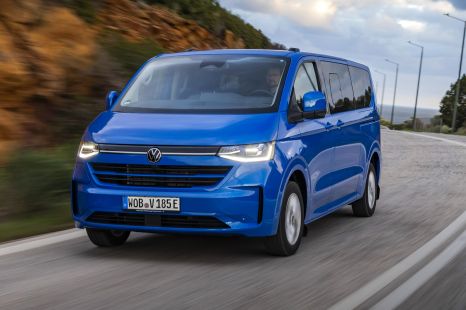

Dave Humphreys
2025 Volkswagen Transporter review: Quick drive
5 Months Ago
The new-generation Ford Transit Custom brings new tech and features and fresh styling without messing with the HiAce rival's strengths.
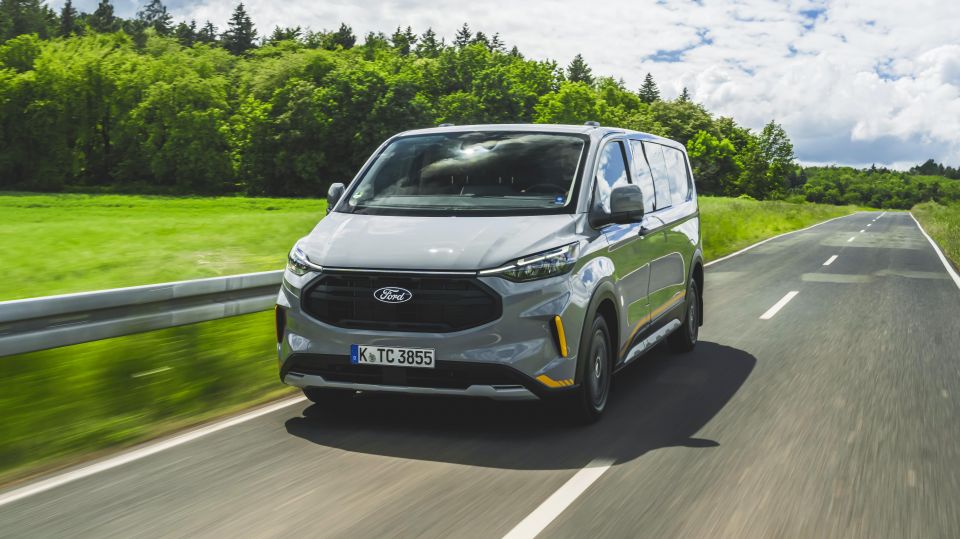


Quickly see how this car stacks up against its competition. Select any benchmark to see more details.
Where expert car reviews meet expert car buying – CarExpert gives you trusted advice, personalised service and real savings on your next new car.
After more than a decade, there’s a new Ford Transit Custom in town and it’s gunning for the Toyota HiAce.

The Blue Oval is touting strong supply of the new van, developed in the UK as a “clean-sheet” design.
Ford claims the new platform is 30 per cent stiffer, while there are weight reductions of up to 100kg compared with the old model. Aerodynamic drag has also been reduced by 13 per cent.
The diesel engines are carried over from the old van, but have been updated.
The new-generation vehicle entered development in 2019, and as part of Ford and Volkswagen’s partnership the Transit Custom will be used as the base for the next-generation Transporter.
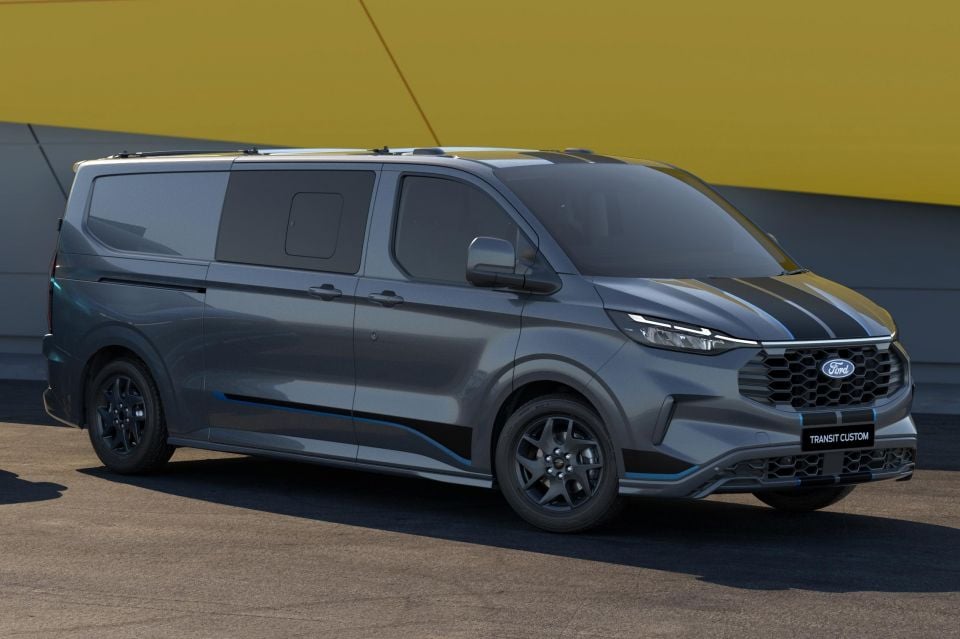
Ford offers a dizzying variety of Transit Custom models in Europe: diesel, petrol plug-in hybrid and electric powertrains; two different lengths; cargo van and crew van models; and either front-, rear- or all-wheel drive depending on the powertrain.
There’s even a crew van body style with an L-shaped bulkhead, perfect for when you have to carry four passengers and long items.
The company says its flexible production in Turkey allows it to easily alter the mix of vehicles, for example increasing output of the electric E-Transit Custom should electric van sales spike.
Ford may offer a wide range of Transit Customs in Europe, where vans are even more popular with tradies and where there’s much less of a ute culture, but the local lineup is a lot simpler: short-wheelbase Trend and Sport vans, a long-wheelbase Trend van, and a long-wheelbase Sport crew van with a second row of seats. All use the same powertrain.
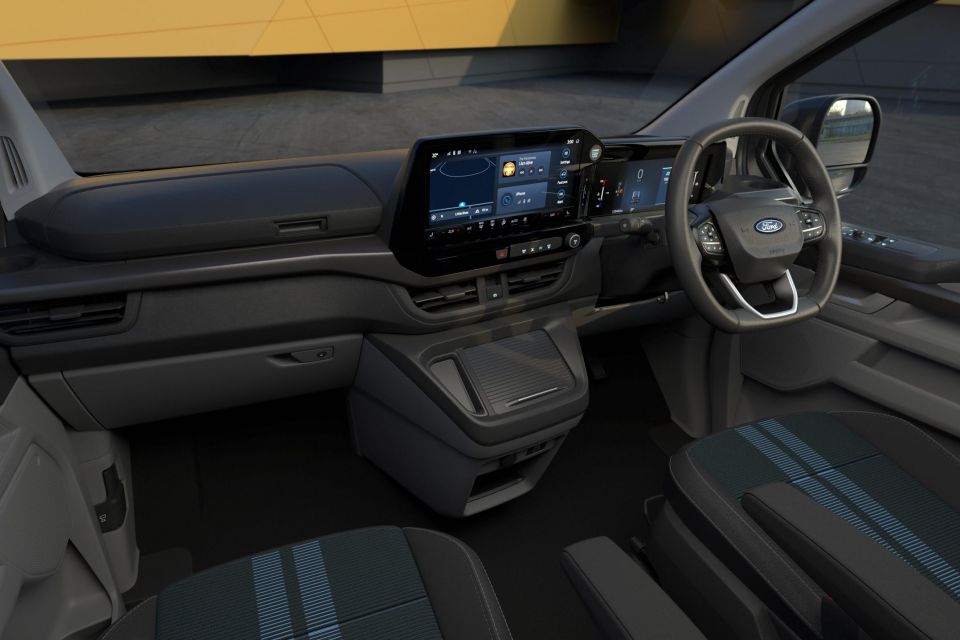
First, a caveat. We didn’t get to drive any diesel-powered Transit Customs that lined up exactly with Australian-spec models.
There were lower-output models with a manual transmission, as well as plug-in hybrid models, the latter of which we briefly sampled.
The bulk of our time with the Transit Custom diesel, however, was in an all-wheel drive, long-wheelbase variant called the Trail.
While we aren’t getting all-wheel drive here, we are getting that particular engine tune so it was the most representative model at the launch event.
The new Transit Custom is already reaching dealerships in base Trend guise, with Sport models following in the third quarter of 2024.
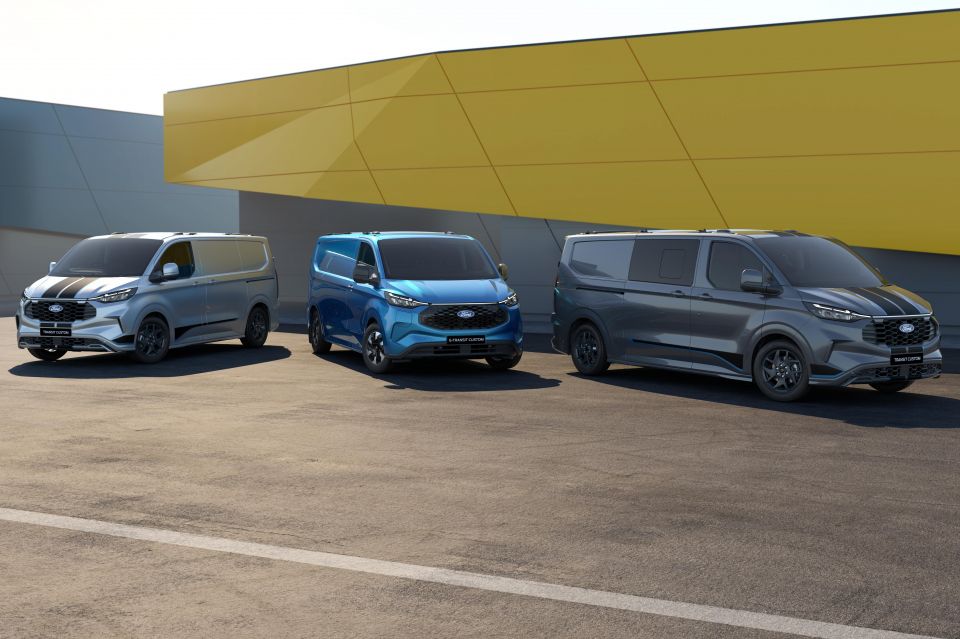
| Model Variant | $RRP |
|---|---|
| Ford Transit Custom Trend SWB | $55,990 |
| Ford Transit Custom Trend LWB | $56,990 |
| Ford Transit Custom Sport SWB | $59,990 |
| Ford Transit Custom Sport LWB Double Cab | $62,990 |
Prices exclude on-road costs
| Dimensions | Transit Custom Trend SWB | Transit Custom Trend LWB |
|---|---|---|
| Length | 5050mm | 5450mm |
| Width (incl. mirrors) | 2275mm | 2275mm |
| Height (at kerb weight) | 1963mm | 1961mm |
| Wheelbase | 3100mm | 3500mm |
To see how the Transit Custom lines up against the competition, check out our comparison tool.
The Transit Custom’s interior feels modern and functional.
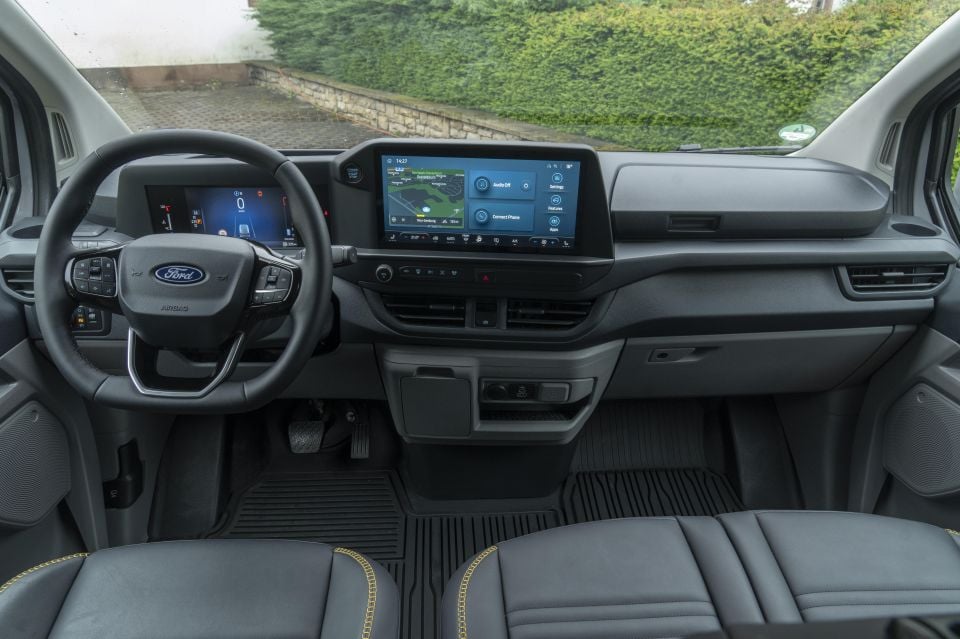
Ford repositioned the front wheels and suspension to make for a more comfortable cabin.
With the gear shifter moving to the column – or, in the case of the not-for-Australia manual, high up on the centre console – it’s now easier to slide across the front seats to exit from either side, though the Sport will feature a slightly different dashboard design that juts out more. On all models, the floor is also completely flat.
The column shifter is a bit of an adjustment. It feels too similar to the stalk on the other side of the steering column, which means you may accidentally pop the car into neutral once in a blue moon when you’re just trying to indicate.
The passenger airbag has been moved to the roof, freeing up space in the dashboard for another storage compartment that’s large enough to fit a laptop.
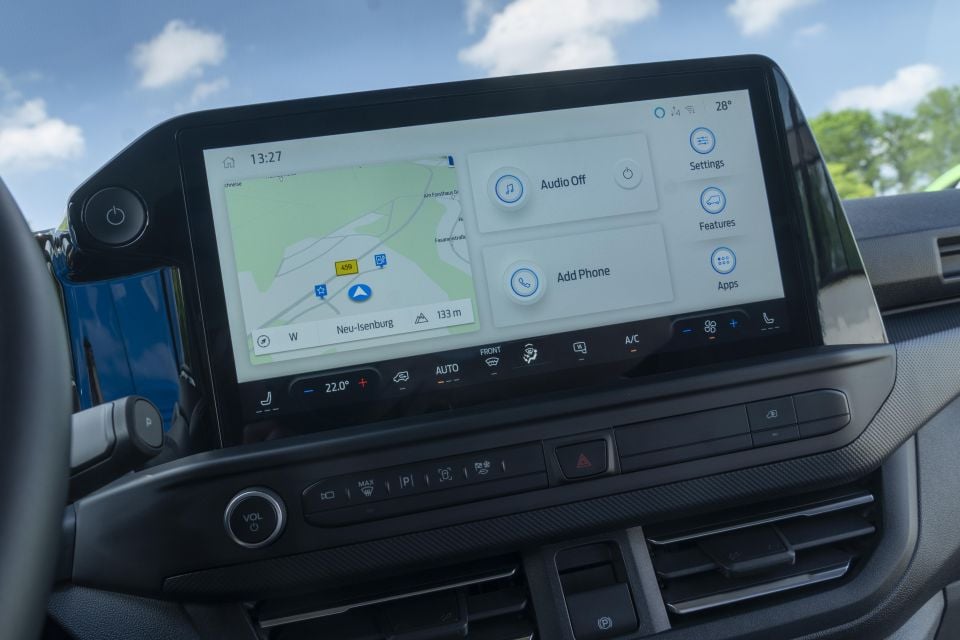
The dashboard is finished in hard (but hard-wearing) plastics suitable for a van, though even this humble cargo carrier couldn’t escape the scourge of gloss-black trim. At least here there’s only a little bit of it, and in places you’re unlikely to touch.
The Trail we drove had comfy seats, with a squishy fold-down armrest, and it was easy to find a suitable seating position. All models in Australia come with an eight-way manually adjustable driver seat.
Standard on all Australian-market models are features like heated front seats and push-button start.
There will be an available Mobile Office Pack that allows you to tilt the steering wheel and then put on a plastic cover, allowing you to work on your laptop from behind the wheel without awkwardly balancing it. Ford also demonstrated it’s the perfect surface to eat your Macca’s off of, too.
This option isn’t available at launch, with Ford promising it’ll come later. Pricing has yet to be announced.
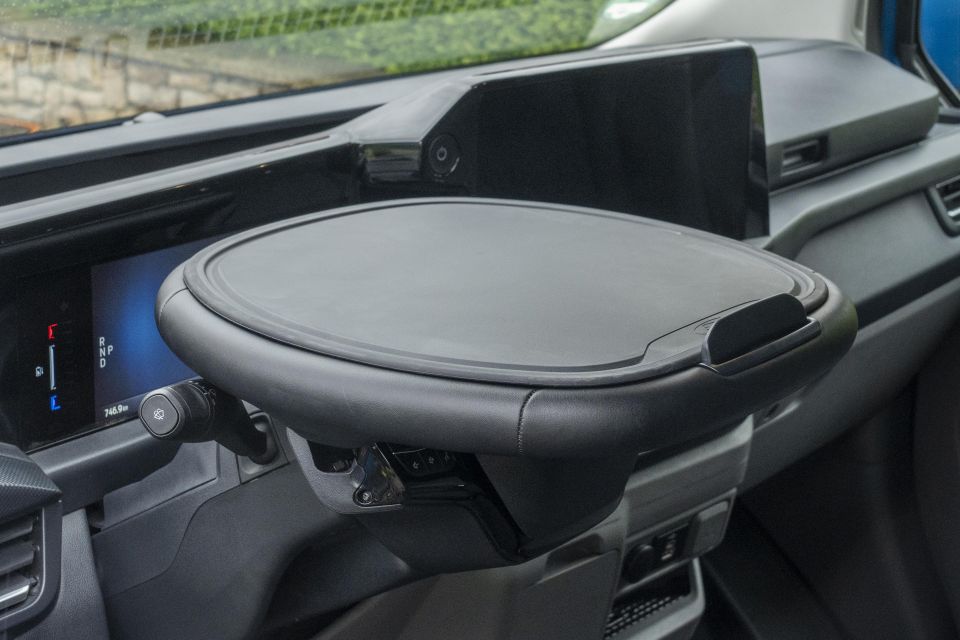
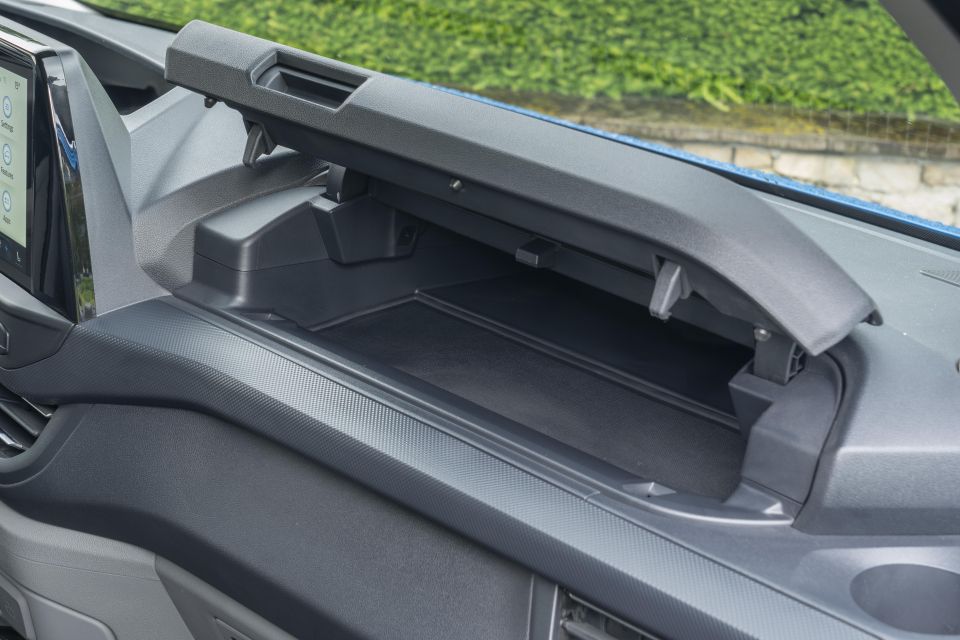
The 12-inch instrument cluster, which includes a 7.0-inch screen, will look familiar to anyone who’s been in a Ranger, and it’s clear and easy to read.
The infotainment system is class-leading. It’s a large 13-inch touchscreen, helpfully angled towards the driver, and all Australian-market models come standard with satellite navigation and wireless connectivity for both Apple CarPlay and Android Auto.
The reversing camera also has a high resolution. Our only complaint about the infotainment system is the maps can be somewhat slow to load.
There are no physical climate controls, with these adjustments instead made via the infotainment touchscreen. These controls are always anchored to the screen, which helps make up for the lack of physical knobs and buttons.
There are some physical controls on the dash, such as the demister switch and a shortcut to the vehicle settings menu, so it’s not like everything has been moved exclusively to the touchscreen.
Do we miss physical climate controls? Yes, but the Transit Custom’s in-car tech is slick and user-friendly.
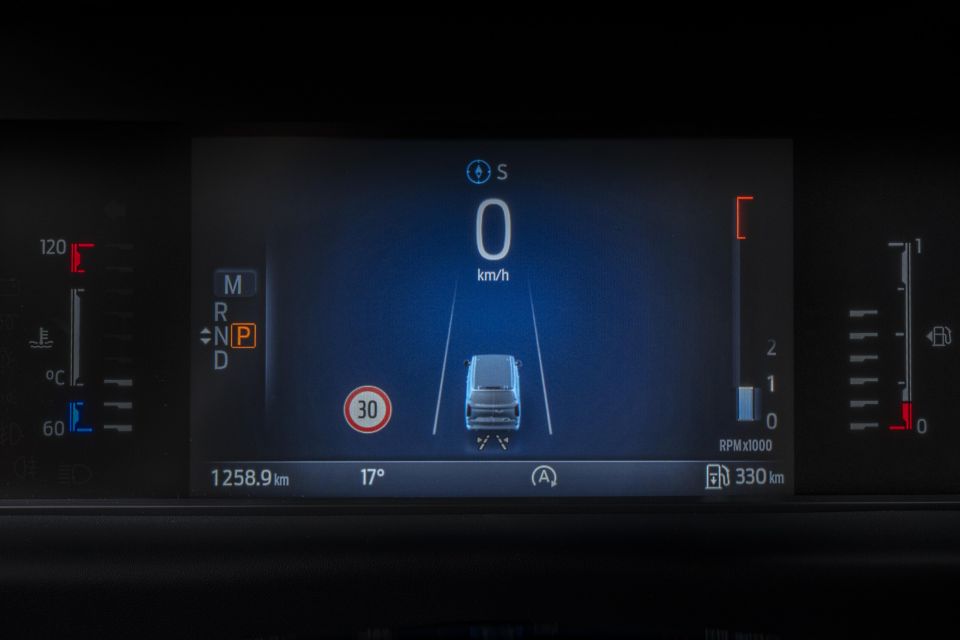
A wireless phone charger is standard, though the way it’s positioned on the dashboard makes it hard to tell if your phone is charging. Above it sits a USB-A and a USB-C charger, while next to it is a pop-out cupholder.
There are also cupholders at either end of the dashboard, a compartment under the passenger seat, a storage shelf behind the infotainment touchscreen and instrument cluster, and large bottle holders and miscellaneous oddment storage in the doors.
Just don’t mistake the shelf halfway down the door as something you should use to pull the door shut, as it’s a flexy bit of plastic.
All models have a full-width metal bulkhead with a window and pass-through hatch. Ford Australia hasn’t confirmed the clever Multicab version, which has a second row of seats like the crew van but with only two individual seats.
In the absence of a third seat, the Multicab has a longer section of the load bay; this results in an L-shaped load bay, so you can carry both passengers in the rear and long items.
Transit Customs in Australia come standard with a kerbside sliding door, though you can equip it with dual sliding doors for $1000. Rear barn doors are standard.
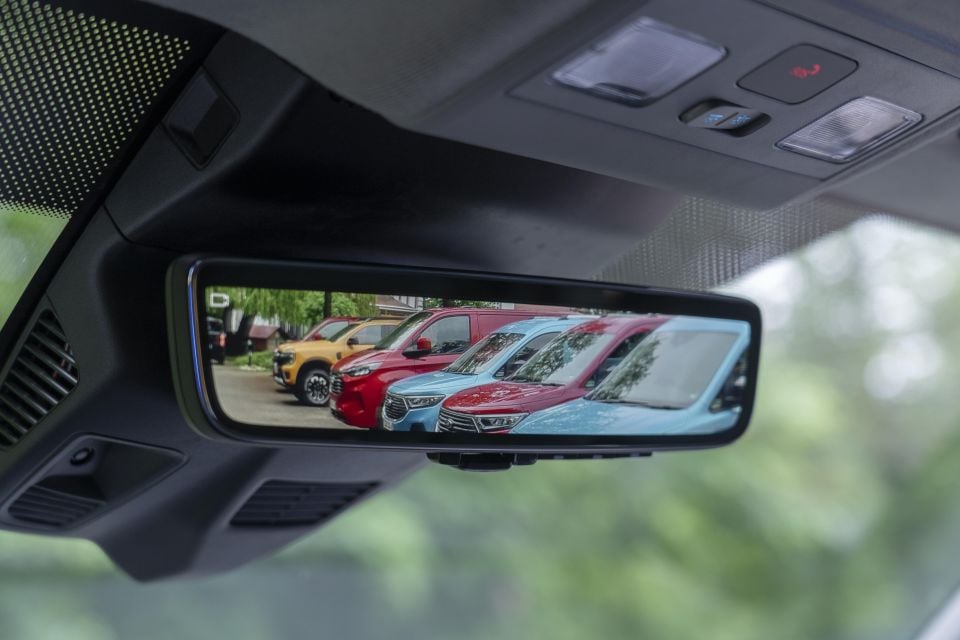
A digital rear-view mirror and integrated dashcam are optional, both of which are exceptionally handy features to have in a van.
Moving to the back, short-wheelbase models have six tie-down loops, while long-wheelbase models add an extra two. The load bay has LED lighting, and air-conditioning for back here is optional.
You can still fit three euro pallets back here, while the bulkhead isn’t too intrusive.
Compared to the old van, the Transit Custom has grown in some key dimensions. Load space height is up by 27mm, while cargo width between the wheel arches is up by 41mm and the maximum load space length including the bulkhead pass-through is up 46mm.
It also has a lower floor height, making it easier to load goods into the back.
However, maximum load volume has shrunk for the SWB Trend from 6m3 to 5.8m3. It remains 6.8m3 in the LWB Trend.
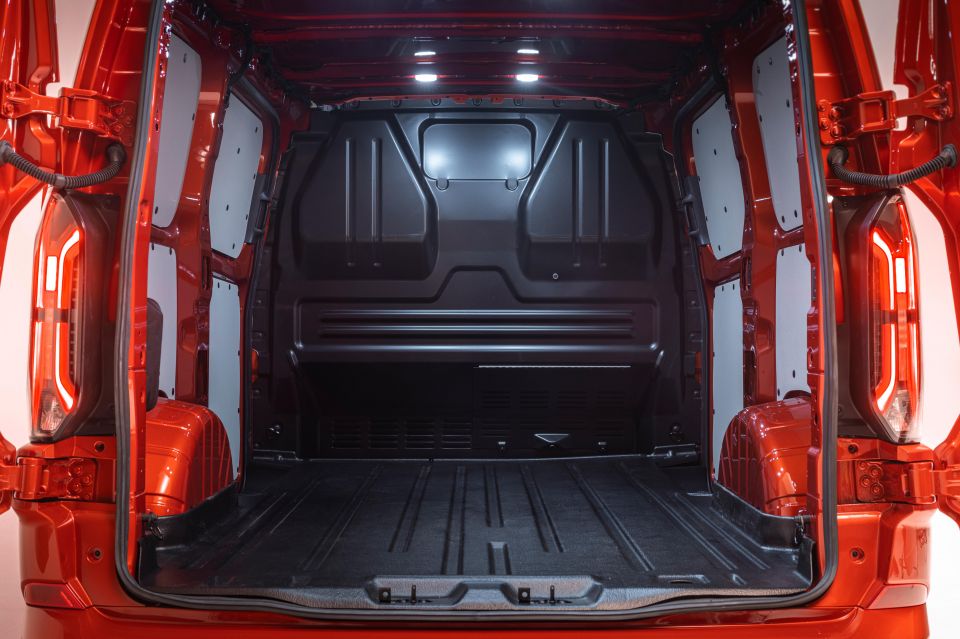
| Dimensions | Transit Custom Trend SWB | Transit Custom Trend LWB |
|---|---|---|
| Side door opening width | 1030mm | 1030mm |
| Side door opening height | 1301mm | 1301mm |
| Rear door opening width | 1400mm | 1400mm |
| Rear door opening height | 1314mm | 1314mm |
| Width between wheel arches | 1392mm | 1392mm |
| Height (load space floor to roof) | 1433mm | 1433mm |
| Load space length (to bulkhead) | 2602mm | 3002mm |
| Load space length (incl. pass-through) | 3050mm | 3450mm |
| Maximum load volume with bulkhead | 5.8m3 | 6.8m3 |
| Load space (behind bulkhead, SAE) | 5.7m3 | 6.5m3 |
| Load space (with bulkhead, VDA) | 5.2m3 | 6m3 |
| Braked towing capacity | 2500kg | 2500kg |
| Gross combined mass | 5725kg | 5725kg |
| Gross vehicle mass | 3225kg | 3225kg |
| Kerb weight (max) | 1956kg | 2002kg |
| Payload | 1269kg | 1223kg |
Payload drops to 1023kg in the SWB Transit Custom Sport and 854kg in the Double Cab model. Braked towing capacity has increased considerably, from 1500-1900kg in the old van, depending on the variant, to 2500kg.
To see how the Transit Custom lines up against the competition, check out our comparison tool.
Just one powertrain will be offered here, apart from the electric powertrain in the E-Transit Custom.
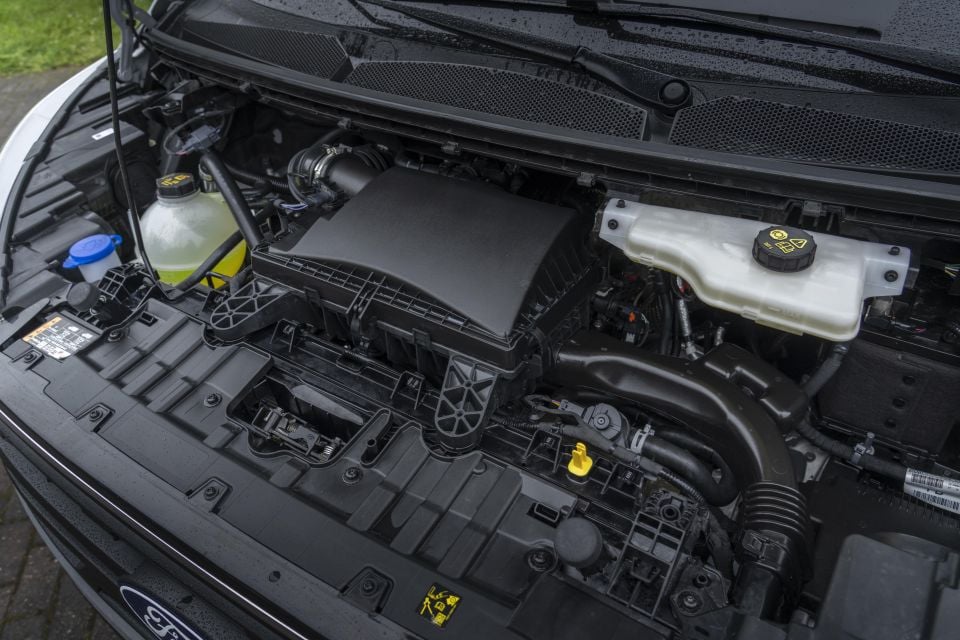
| Technical Specs | Ford Transit Custom |
|---|---|
| Engine | 2.0-litre 4cyl turbo-diesel |
| Power | 125kW @ 3500rpm |
| Torque | 390Nm @ 1750-2500rpm |
| Drive type | Front-wheel drive |
| Transmission | 8-speed automatic |
| Fuel economy (claimed) | 8.0L/100km |
| Fuel tank | 70L |
To see how the Transit Custom lines up against the competition, check out our comparison tool.
We recently reviewed the related Tourneo, which is up against the more car-like Kia Carnival in the people mover segment and feels as though it requires more finessing. In short, it doesn’t feel quite car-like enough.
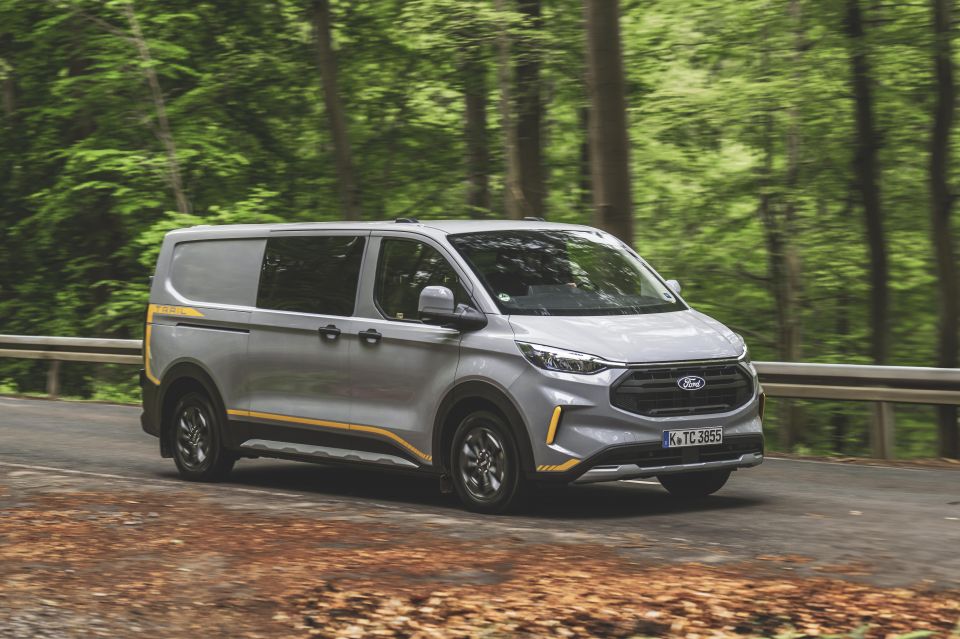
The Transit Custom, in contrast, is up against rivals like the Toyota HiAce and Hyundai Staria Load. Against this competitive set it stacks up quite well and feels quite car-like for a van.
Take the steering. First, before you even start up the van, you’ll find the Sensico leatherette-wrapped wheel is chunky and tactile, with intuitive switchgear.
Once you’re on the move, you’ll find the steering to be comfortably light. You genuinely feel as though you could drive this van one-handed, and given you can easily find a comfortable seating position in the comfy driver’s seat, this is quite a nice place to be in traffic or while out on the open road.
The Transit Custom never feels too ungainly to drive, even on tighter city streets, which is great if you’re a courier or delivery driver and spend most of your time in the urban jungle.
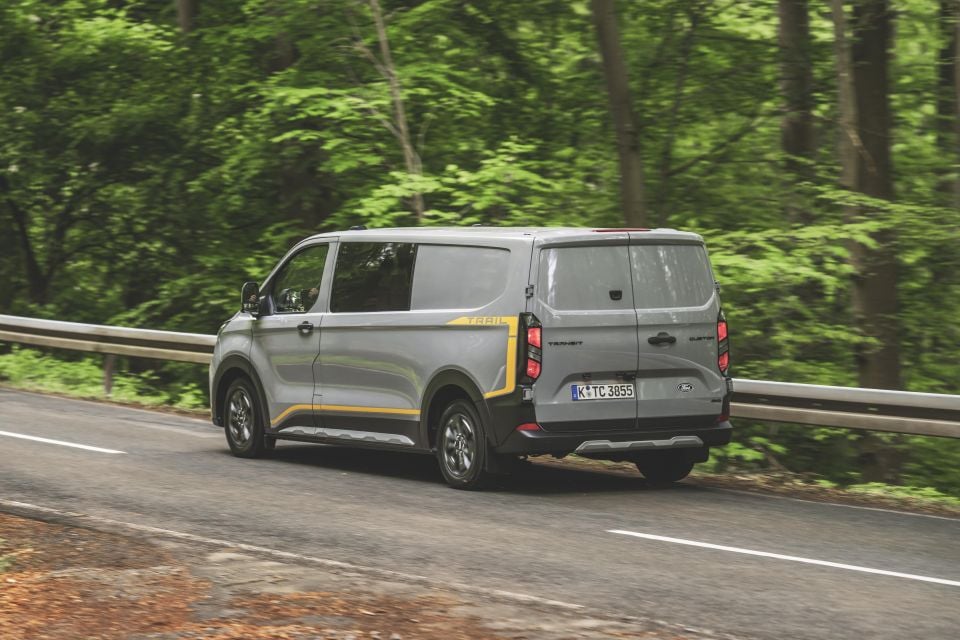
Where expert car reviews meet expert car buying – CarExpert gives you trusted advice, personalised service and real savings on your next new car.
The Transit Custom is also under 2.0m tall, so you won’t have any problem getting into your typical shopping centre car park.
We’re only getting the more powerful 125kW turbo-diesel engine here, and it has a satisfactory amount of grunt for this segment.
Ford had put roughly half the Transit Custom payload’s worth of weight in the back, but even so laden it didn’t feel winded.
The turbo-diesel engine is mated to an eight-speed automatic transmission that isn’t the smoothest unit. It doesn’t jolt between gears, but gear changes are noticeable and some more finessing would be welcome.
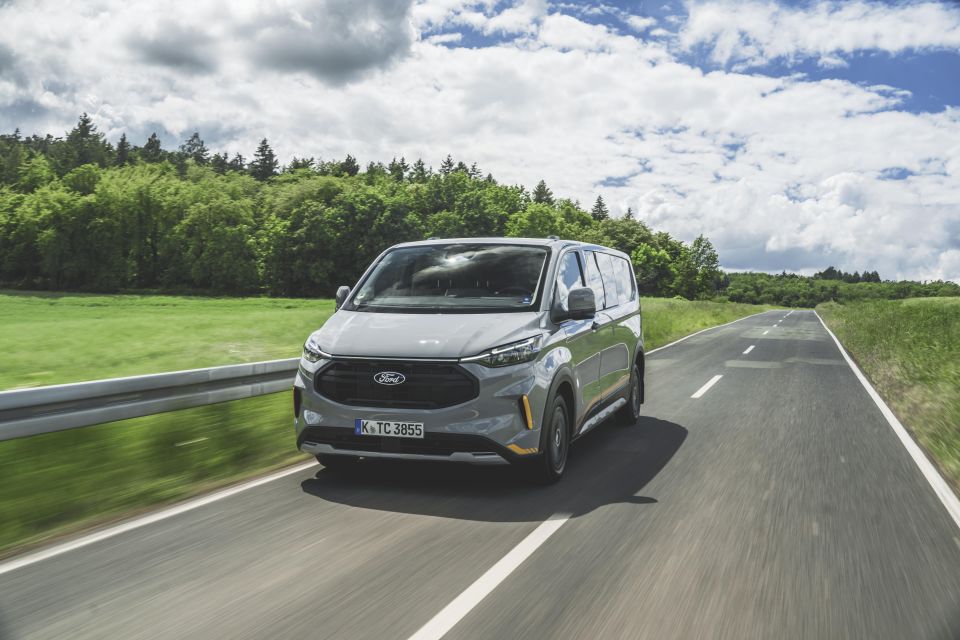
There’s the usual rattly diesel engine note you find in most vans, but the Transit Custom is quite refined for the segment.
Just don’t put it in Sport, where it holds gears for far too long and makes the car noisy and obnoxious.
Ride comfort is also good for the segment, though we were driving the van in Germany where the roads are typically of a much higher standard than Australia’s.
Even with independent rear suspension it does occasionally feel a bit choppy, and you will notice expansion joints, but overall it’s refined for a van.
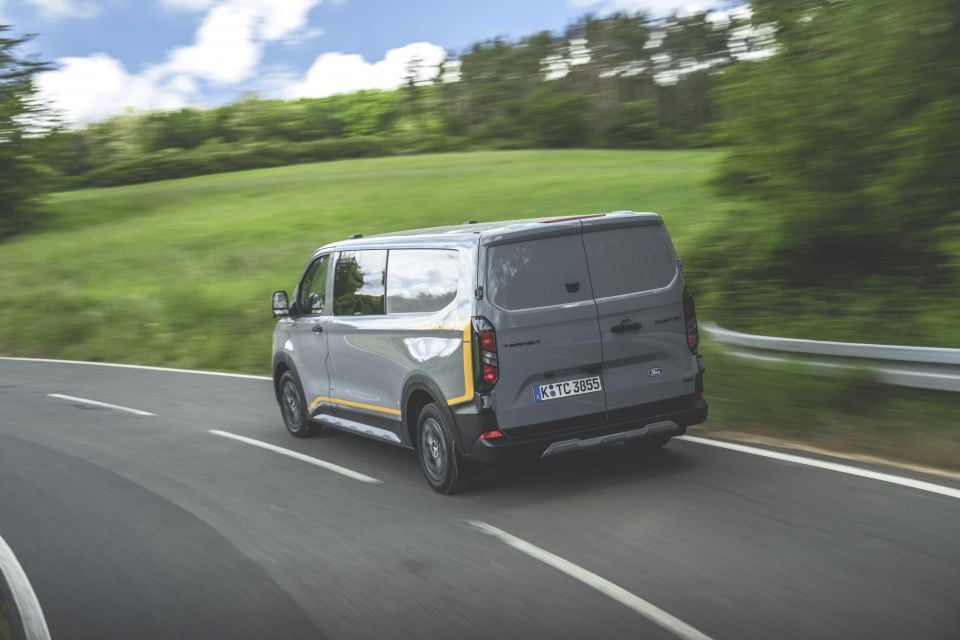
The traffic sign recognition reliably read road signs, and the intelligent speed limit assist seamlessly changed the adaptive cruise control speed whenever the limit changed.
There’s no lane centring, but the lane-keep assist worked well at keeping us within our lane even on curvy roads without feeling omnipresent and overbearing.
We averaged 9.5L/100km on a fairly short drive loop consisting of a mix of suburban and highway driving.
Ford Australia says there are no plans to bring the thriftier plug-in hybrid Transit Custom here.
This mates a 2.5-litre Atkinson cycle petrol four-cylinder engine with a 11.8kWh (useable) battery, with a total system output of 171kW and claimed WLTP electric range of 56km.
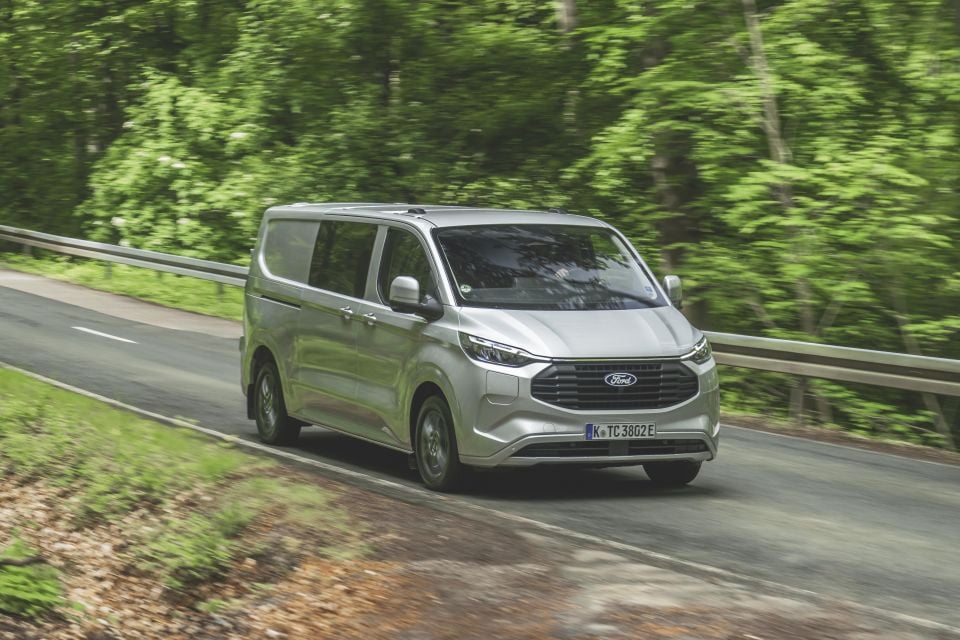
If that powertrain sounds familiar, that’s because the defunct Escape Plug-In Hybrid – sold as the Kuga Plug-In Hybrid, and still Europe’s best-selling PHEV – uses the same basic powertrain.
The Transit Custom PHEV also features Pro Power Onboard like the E-Transit Custom, allowing you to power tools, lights and appliances.
It’s a shame we won’t get the PHEV. We had a brief drive of this model and found the transitions between electric and petrol power smooth, while there was plenty of grunt.
It’s always a bit unusual to hear a petrol engine note in a van, but it’s certainly easier on the ears than the diesel.
The Transit Custom will be offered here in two trim levels: Trend and Sport.
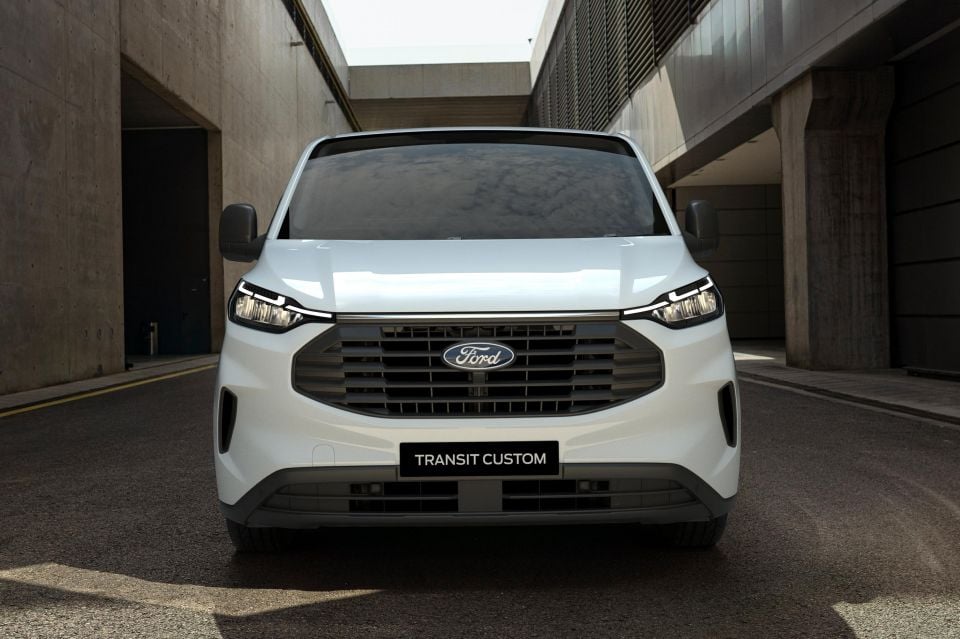
Standard equipment on the Trend includes:
The Sport adds:
The following options are available on the Trend:
We’d like to see a digital rear-view mirror be a standalone option across the range, as it’s a very useful feature to have.
While the related Tourneo has three- and four-star safety ratings from Euro NCAP depending on specification, the Transit Custom doesn’t have a traditional star rating from the safety authority encompassing aspects like occupant protection.
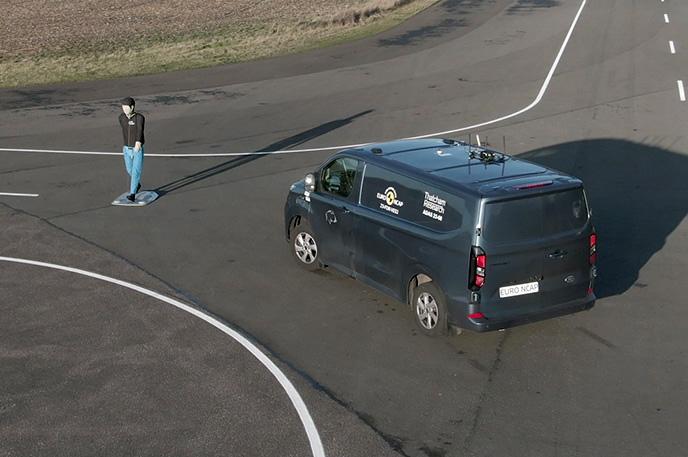
It does, however, have a Platinum rating from Euro NCAP based on testing of its driver assist technology.
Standard safety equipment across the range includes:
Ford backs its vehicles with a five-year, unlimited-kilometre warranty.
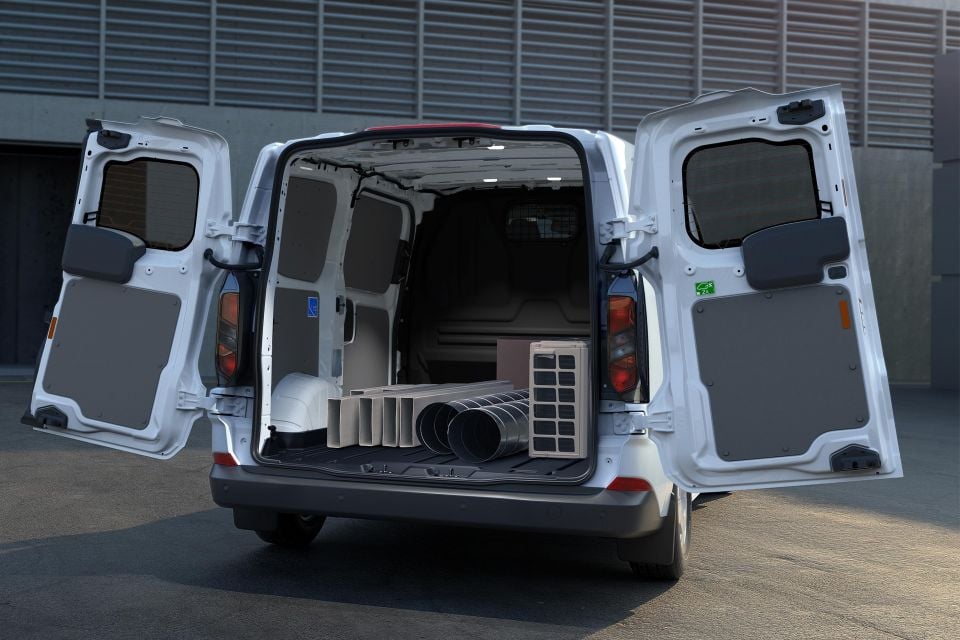
Servicing is required every 12 months or 30,000km, whichever comes first, and is priced as follows for retail and small business customers:
| Service Interval | Price |
|---|---|
| 1 year/30,000km | $499 |
| 2 years/60,000km | $499 |
| 3 years/90,000km | $499 |
| 4 years/120,000km | $499 |
| 5 years/150,000km | $575 |
For other buyers, these services are priced at $580, $915, $715, $915 and $575, respectively. You only pay $290 per service with a HiAce, but the Toyota requires servicing every six months or 10,000km – a considerably shorter interval than with the Ford.
The Transit Custom is a smartly packaged, well-equipped van.

It builds on the strengths of the old van, with better tech and more modern styling.
The interior is more functional and user-friendly in some respects (easier accessibility, more storage), less so in others (awkward column shifter, no physical climate controls).
The same applies to the cargo bay. It’s easier to load goods into than before, but it’s slightly smaller in some measurements.
There’s no doubt the Transit Custom is a good van, but it isn’t a cheap van.

The HiAce range opens at $48,886 before on-road costs in manual guise, while even the cheapest auto is $50,886 before on-roads – around $5000 less than the cheapest Transit Custom. It also offers a long-wheelbase configuration as standard, though its feature list isn’t quite as long as the Ford’s.
If the bottom line is the most important thing to you, there are also LDV’s various vans to consider.
Not only is the new Transit Custom an impressive package overall, however, Ford promises there will be strong supply, while it also has an electric version coming later this year – something Toyota can’t match.
Will this be enough to see the Transit Custom overtake the dominant HiAce as the Ford Ranger has done the HiLux? That remains to be seen.
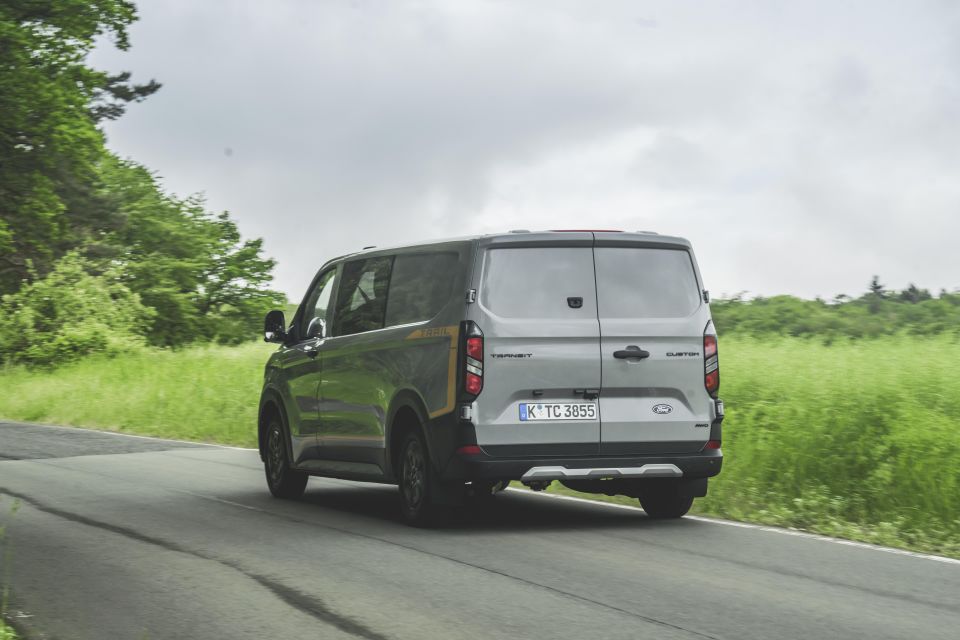
Click the images for the full gallery
MORE: Buy a Ford Transit Custom MORE: Everything Ford Transit Custom
Where expert car reviews meet expert car buying – CarExpert gives you trusted advice, personalised service and real savings on your next new car.
William Stopford is an automotive journalist based in Brisbane, Australia. William is a Business/Journalism graduate from the Queensland University of Technology who loves to travel, briefly lived in the US, and has a particular interest in the American car industry.


Dave Humphreys
5 Months Ago
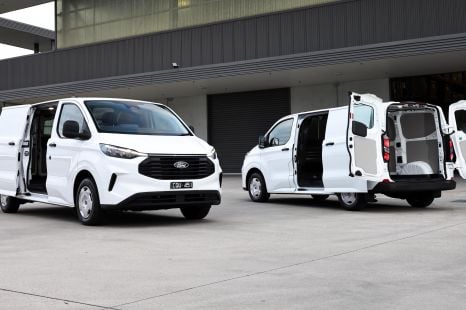

Max Davies
5 Months Ago


Josh Nevett
4 Months Ago
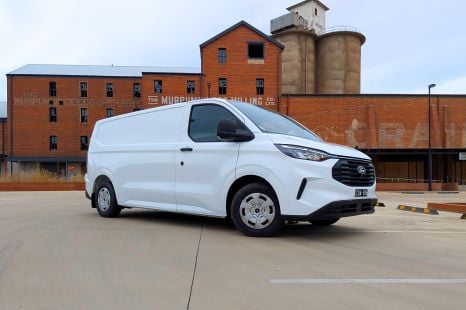

William Stopford
3 Months Ago
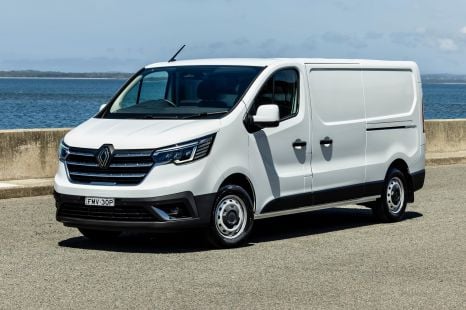

Max Davies
3 Months Ago
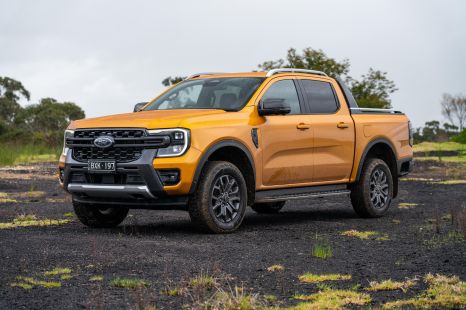

William Stopford
2 Months Ago